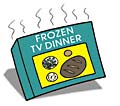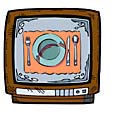You will need:
- 3 lbs pork roast
- 1 12-oz. container orange juice concentrate
- 1 yellow or white onion (small or large it doesn't matter)
- 1 cup salsa
- 5 cloves garlic
- 2 tbs. dried oregano (make sure it smells nice and strong! dusty smell=dusty taste)
- salt and pepper to taste
crush or dice the garlic
season the pork roast with salt, pepper, oregano, and garlic
place half of the onion in the bottom of a crock pot
then place the pork in the crock
top with the remaining onion, and 2/3 to 3/4 of the orange juice concentrate
set on low for 8-12 hours (or overnight)
remove the roast, and allow to cool slightly
shred the roast, and place in a skillet with 1/4 cup of the drippings, remaining orange juice concentrate, and salsa
simmer about 30 minutes
*you can simmer it longer if the mixture is too watery
First I assemble my ingredients (Aren't those salt and pepper shakers cute? They were a Christmas present from my Sister-in-law)

I don't want to cook the pork for the usual 10 hours, so I cut it up a bit

Tossing the roast pieces with the garlic, salt, pepper, and oregano

Into the crock we go! Half of the onions are on the bottom, half on top, and the OJ over everything

... After 6 hours

This is the final product!


I don't want to cook the pork for the usual 10 hours, so I cut it up a bit

Tossing the roast pieces with the garlic, salt, pepper, and oregano

Into the crock we go! Half of the onions are on the bottom, half on top, and the OJ over everything

... After 6 hours

This is the final product!




 In 1945, Maxson Food Systems, Inc. manufactured the very first complete frozen meals in what were known as "Strato Plates." Military and civilian passengers consumed them on airlines and they only required reheating before serving (the plates, not the passengers). The meals consisted of three parts: meat, vegetable and potato, each given its own special, third class compartment on the plate. The concept never hit the retail market due to lack of funding and the death of Maxson. Some experts argue that Maxson’s creations do not qualify as true TV dinners because they were consumed on airplanes and not in homes while watching television. (A moot, if not frozen point.)
In 1945, Maxson Food Systems, Inc. manufactured the very first complete frozen meals in what were known as "Strato Plates." Military and civilian passengers consumed them on airlines and they only required reheating before serving (the plates, not the passengers). The meals consisted of three parts: meat, vegetable and potato, each given its own special, third class compartment on the plate. The concept never hit the retail market due to lack of funding and the death of Maxson. Some experts argue that Maxson’s creations do not qualify as true TV dinners because they were consumed on airplanes and not in homes while watching television. (A moot, if not frozen point.) The TV dinner actually grabbed the ears, nose, mouth, heart and stomach of the retail world in 1954 when Swanson frozen meals first displayed their icy faces in the frozen food sections of the supermarket. At the time, C. A. Swanson and Sons was a subsidiary of the Campbell Soup Company. A well-established name that customers knew and trusted, the company capitalized on that, pushing their product even further through massive advertising campaigns. These meals were featured on television commercials by the top celebrities of the day, including Howdy Doody and even President Eisenhower. The term, TV dinner, turned an everyday meal into a cultural experience and revolutionized the idea of "preparing dinner."
The TV dinner actually grabbed the ears, nose, mouth, heart and stomach of the retail world in 1954 when Swanson frozen meals first displayed their icy faces in the frozen food sections of the supermarket. At the time, C. A. Swanson and Sons was a subsidiary of the Campbell Soup Company. A well-established name that customers knew and trusted, the company capitalized on that, pushing their product even further through massive advertising campaigns. These meals were featured on television commercials by the top celebrities of the day, including Howdy Doody and even President Eisenhower. The term, TV dinner, turned an everyday meal into a cultural experience and revolutionized the idea of "preparing dinner." Betty Cronin, a bacteriologist who also worked for Swanson Brothers at that time, claims that it was the brothers Swanson, Gllbert and Clarke to be specific, who came up with the idea of the TV dinner. Cronin herself worked on the project (Operation Frozen Blue Plate Special?). Her technical challenge was synchronization, that is, to compose a dinner in which all the ingredients took the same time to cook.
Betty Cronin, a bacteriologist who also worked for Swanson Brothers at that time, claims that it was the brothers Swanson, Gllbert and Clarke to be specific, who came up with the idea of the TV dinner. Cronin herself worked on the project (Operation Frozen Blue Plate Special?). Her technical challenge was synchronization, that is, to compose a dinner in which all the ingredients took the same time to cook. Desserts were not available at this time, but they were added in 1960 and included apple cobbler and brownies in a new four-part tray. In 1969, breakfasts of pancakes and sausage were introduced to an ever waiting frozen public. A metal tray divided all the portions and in 1987, a representative tray was placed in the Smithsonian Institute to commemorate the impact of the TV dinner on the American dining experience. The Swanson "TV dinner" had its swan song in the 1960s and in 1986, the Campbell Soup Company replaced the aluminum trays with plastic microwavable trays. In 1999, Swanson received its very own star on the Hollywood Walk of Fame.
Desserts were not available at this time, but they were added in 1960 and included apple cobbler and brownies in a new four-part tray. In 1969, breakfasts of pancakes and sausage were introduced to an ever waiting frozen public. A metal tray divided all the portions and in 1987, a representative tray was placed in the Smithsonian Institute to commemorate the impact of the TV dinner on the American dining experience. The Swanson "TV dinner" had its swan song in the 1960s and in 1986, the Campbell Soup Company replaced the aluminum trays with plastic microwavable trays. In 1999, Swanson received its very own star on the Hollywood Walk of Fame.